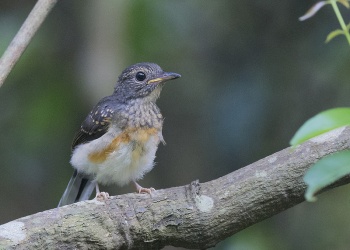- Copsychus malabaricus
Identification
21–28 cm (8¼-11 in)
- Black bill
- Pink feet
Male
- Glossy black
- Chestnut belly
- White feathers on the rump and outer tail
Females: grey-brown head and back. Tail shorter than males
Juvenile: similar to the female, with blotches or spots on the chest. Reduced orange on underparts.
Distribution
South and south east Asia.
Introduced to Kaua'i, O'ahu and Moloka'i, in the Hawaiian Islands. Seems to be spreading to other islands in Maui County.
Taxonomy

Photo © by Alok Tewari
Karnala Bird Sanctuary, Dist. Raigad, Maharashtra, India, 3 October 2013
Sometimes placed in genus Kittacincla. Andaman Shama and White-crowned Shama were formerly included in this species.
Subspecies

Photo © by Alok Tewari
Dudhwa National Park, Himalayan Terai, India, 29 January 2015
Clements recognizes 13 subspecies[1].
- C. m. malabaricus: Southern peninsula India
- C. m. leggei: Sri Lanka
- C. m. macrourus: Nepal to northeastern India, southwestern China and Hainan Island), Myanmar, Thailand, Indochina (including Con Son Island, southern Vietnam), and the northern Thai-Malay Peninsula; the species also is introduced on Taiwan (subspecies not confirmed, possibly macrourus) and the Hawaiian Islands (probably macrourus)
- C. m. tricolor: Southern Thai-Malay Peninsula, Sumatra, Riau and Lingga Archipelagos, Bangka and Belitung islands, Anambas Islands, Natuna Islands, and western Java
- C. m. javanus: Central Java
- C. m. omissus: Eastern Java
- C. m. suavis: Borneo (except northern part)
- C. m. nigricauda: Kangean Islands and Matasiri Island (Java Sea)
- C. m. ngae: islands on the west side of the Thai-Malay Peninsula (from the Thailand/Myanmar border south to the Langkawi archipelago at the Thai/Malayasian border)
- C. m. hypolizus: Simeulue Island, west coast of Sumatra
- C. m. opisthochrus: Lasia and Babi Islands, west coast of Sumatra; possibly extinct in the wild
- C. m. melanurus: Nias Island and Mentawai Islands, west coast of Sumatra
- C. m. mirabilis: Prinsen Island (Sunda Strait); possibly extinct
Former subspecies C. m. indicus and C. m. interposita now merged with C. m. macrourus
Habitat
Valley forests and lowland broadleaf forests.
Behaviour
Breeding
The nest is built of roots, leaves and other vegetative material which is placed near the ground. The eggs are white to light bluey-green, with brown blotches. Incubate takes between 12 and 15 days.
Diet
The diet includes grasshoppers, termites, caterpillars, grubs, and fruit. The young are fed earthworms and insects.
Vocalisation
The song one of the finest of any bird within its range, a variable series of powerful rich fluty melodious notes. Often includes imitations of other birds including the Melodious Laughing-thrush
Listen in a White-rumped Shama sound clip
Recording by wavethree
Pulau Ubin, Singapore
Movements
Sedentary
References
- Clements, J. F., P. C. Rasmussen, T. S. Schulenberg, M. J. Iliff, T. A. Fredericks, J. A. Gerbracht, D. Lepage, A. Spencer, S. M. Billerman, B. L. Sullivan, and C. L. Wood. 2023. The eBird/Clements checklist of Birds of the World: v2023. Downloaded from https://www.birds.cornell.edu/clementschecklist/download/
- Gill, F, D Donsker, and P Rasmussen (Eds). 2023. IOC World Bird List (v 13.2). Doi 10.14344/IOC.ML.13.2. http://www.worldbirdnames.org/
- Wikipedia contributors. (2020, January 21). White-rumped shama. In Wikipedia, The Free Encyclopedia. Retrieved 00:39, February 4, 2020, from https://en.wikipedia.org/w/index.php?title=White-rumped_shama&oldid=936833552
- Collar, N. & Kirwan, G.M. (2020). White-rumped Shama (Kittacincla malabarica). In: del Hoyo, J., Elliott, A., Sargatal, J., Christie, D.A. & de Juana, E. (eds.). Handbook of the Birds of the World Alive. Lynx Edicions, Barcelona. (retrieved from https://www.hbw.com/node/58486 on 4 February 2020).
- Pratt, H.D., Bruner, P., and Berrett, D.G. (1987) A Field Guide to the Birds of Hawaii and the Tropical Pacific. Princeton University Press.
- Pyle, R.L., and P. Pyle. 2017. The Birds of the Hawaiian Islands: Occurrence, History, Distribution, and Status. B.P. Bishop Museum, Honolulu, HI, U.S.A. Version 2 (1 January 2017) http://hbs.bishopmuseum.org/birds/rlp-monograph/
- Roberts , G. E., T. D. Male, and C. Sheila (1998). White-rumped Shama (Copsychus malabaricus), version 2.0. In The Birds of North America (A. F. Poole and F. B. Gill, Editors). Cornell Lab of Ornithology, Ithaca, NY, USA. https://doi.org/10.2173/bna.378
Recommended Citation
- BirdForum Opus contributors. (2024) White-rumped Shama. In: BirdForum, the forum for wild birds and birding. Retrieved 9 November 2024 from https://www.birdforum.net/opus/White-rumped_Shama
External Links
GSearch checked for 2020 platform.1





